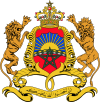Falus
Appearance


| History of Morocco |
|---|
 |
The falus was a bronze/copper currency of Morocco.
Minted between 1672–1901, denominations of ¼, ½, 1, 2, 3, 4, 6, and 8 falus are recorded in the Standard Catalogue.[1]
Identification
They are typically denominated by size rather than by inscription, and can be difficult to identify precisely.
Depreciation
From 1862, the falus was allowed to float, while the exchange rate for the silver dirham was fixed: This resulted in currency speculation and depreciation, with effectively two parallel currencies.[2]
References
- ^ "Morocco". NumisMaster.com. Archived from the original on 11 February 2010. Retrieved 12 July 2009.
- ^ Pennell, C.R. (2001). Morocco since 1830: A History. New York: New York University Press. pp. 79–80. ISBN 0-8147-6677-3.
See also
